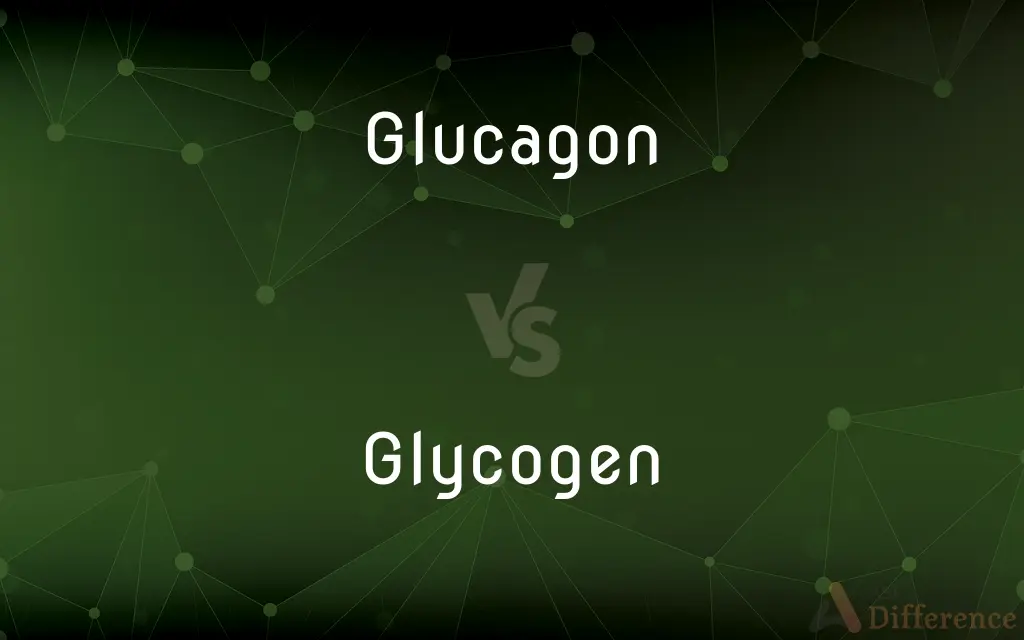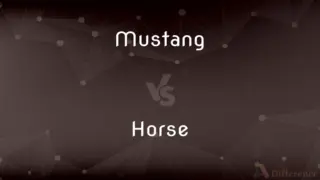Glucagon vs. Glycogen — What's the Difference?
Edited by Tayyaba Rehman — By Urooj Arif — Updated on April 15, 2024
Glucagon, a hormone, raises glucose levels by promoting glycogen breakdown, whereas glycogen, a polysaccharide, stores glucose in the liver and muscles.

Difference Between Glucagon and Glycogen
Table of Contents
ADVERTISEMENT
Key Differences
Glucagon is produced by the pancreas, specifically by alpha cells, which release it when sugar levels drop. Whereas glycogen is not a hormone but a complex carbohydrate that serves as the primary storage form of glucose in the body.
Glucagon functions as a signaling molecule that triggers the conversion of stored glycogen into glucose in the liver. On the other hand, glycogen acts as a fuel reserve that can be rapidly mobilized to maintain glucose levels.
Glucagon plays a crucial role in maintaining energy balance and is particularly important during fasting or between meals. While glycogen provides a readily available source of energy during physical activity or when dietary glucose is not available.
Glucagon has a catabolic effect, meaning it helps to break down larger molecules into smaller ones to release energy. Whereas glycogen is synthesized from glucose molecules in a process known as glycogenesis, primarily during periods of high sugar level.
Glucagon increases glucose levels by stimulating glycogenolysis (the breakdown of glycogen) and gluconeogenesis (the production of glucose from non-carbohydrate sources). On the other hand, glycogen acts as a buffer to prevent hypoglycemia, being broken down when glucose levels need to be augmented.
ADVERTISEMENT
Comparison Chart
Nature
Hormone
Polysaccharide
Production Site
Pancreas (alpha cells)
Liver and muscles
Primary Action
Stimulates glycogen breakdown
Serves as a glucose reserve
Role in Metabolism
Catabolic (breaks down molecules)
Anabolic (builds up molecules)
Compare with Definitions
Glucagon
Counter-regulatory to insulin.
Unlike insulin, glucagon raises glucose levels.
Glycogen
Synthesized from glucose via glycogenesis.
After a high-carb meal, excess glucose is converted to glycogen.
Glucagon
Stimulates glycogenolysis and gluconeogenesis.
Glucagon helps to convert stored glycogen into glucose.
Glycogen
A branched polymer of glucose that serves as an energy reserve.
Glycogen stores provide energy during exercise.
Glucagon
Essential for glucose homeostasis.
Glucagon plays a key role in regulating energy use.
Glycogen
Helps regulate sugar levels.
Glycogen breakdown prevents hypoglycemia during fasting.
Glucagon
Produced in the pancreas.
The pancreas releases glucagon when it detects low glucose levels.
Glycogen
Stored in liver and muscle cells.
Muscle glycogen is vital for prolonged physical activity.
Glucagon
(biochemistry) A peptide hormone, produced by the pancreas, that opposes the action of insulin by stimulating the production of sugar
Glycogen
Broken down into glucose when needed.
During fasting, the liver breaks down glycogen to release glucose.
Glycogen
Glycogen is a multibranched polysaccharide of glucose that serves as a form of energy storage in animals, fungi, and bacteria. The polysaccharide structure represents the main storage form of glucose in the body.
Glycogen
A polysaccharide, (C6H10O5)n, that is the main form of carbohydrate storage in animals and is found primarily in the liver and muscle tissue. It is readily converted to glucose as needed by the body to satisfy its energy needs. Also called animal starch.
Glycogen
(carbohydrate) A polysaccharide that is the main form of carbohydrate storage in animals; converted to glucose as needed.
Glycogen
A white, amorphous, tasteless substance resembling starch, soluble in water to an opalescent fluid. It is found abundantly in the liver of most animals, and in small quantity in other organs and tissues, particularly in the embryo. It is quickly changed into sugar when boiled with dilute sulphuric or hydrochloric acid, and also by the action of amylolytic ferments.
Glycogen
One form in which body fuel is stored; stored primarily in the liver and broken down into glucose when needed by the body
Common Curiosities
How is glycogen structured differently from glucose?
Glycogen is a polysaccharide formed by repeated units of glucose linked together, creating a large, branched structure.
What triggers the release of glucagon?
Glucagon is released in response to low glucose levels.
How do glucagon and insulin work together?
Glucagon and insulin are counter-regulatory; glucagon increases glucose levels, while insulin decreases them.
Where is glycogen stored in the human body?
Glycogen is primarily stored in the liver and muscle tissues.
How long can glycogen stores in the body last?
Glycogen stores can typically sustain energy needs for up to 24 hours under normal activity levels.
Is glycogen found in other animals or just humans?
Glycogen is found in virtually all animals as a form of energy storage.
What happens when glucagon is deficient?
A deficiency in glucagon can lead to chronic hypoglycemia, especially in cases of pancreatic alpha cell dysfunction.
What is the maximum capacity of glycogen storage in the human body?
The capacity varies, but the liver can store about 100-120 grams, and muscles can store around 250-400 grams.
Can glycogen be converted back into glucose?
Yes, glycogen can be broken down into glucose through glycogenolysis.
How does glucagon affect fat metabolism?
Glucagon promotes the breakdown of fats into fatty acids and glycerol, providing additional energy sources.
How does exercise affect glycogen levels?
Exercise depletes muscle glycogen stores, which are later replenished from dietary carbohydrates.
What factors influence glycogen synthesis?
Insulin levels, dietary carbohydrate intake, and current energy needs influence glycogen synthesis.
Share Your Discovery

Previous Comparison
Mustang vs. Horse
Next Comparison
Interpol vs. CiaAuthor Spotlight
Written by
Urooj ArifUrooj is a skilled content writer at Ask Difference, known for her exceptional ability to simplify complex topics into engaging and informative content. With a passion for research and a flair for clear, concise writing, she consistently delivers articles that resonate with our diverse audience.
Edited by
Tayyaba RehmanTayyaba Rehman is a distinguished writer, currently serving as a primary contributor to askdifference.com. As a researcher in semantics and etymology, Tayyaba's passion for the complexity of languages and their distinctions has found a perfect home on the platform. Tayyaba delves into the intricacies of language, distinguishing between commonly confused words and phrases, thereby providing clarity for readers worldwide.















































